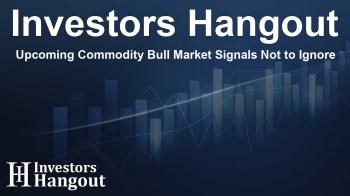Upcoming Commodity Bull Market Signals Not to Ignore

Understanding Commodity Rotation Signals
In the realm of commodities, a significant event occurs infrequently, marking the onset of major shifts, new market trends, and exceptional profitability for strategic investors. These pivotal moments often come in the form of rotation signals, specifically concerning the commodity-to-gold ratio, which gauges the relationship between various commodities and gold prices.
The analysis of the commodity-to-gold (C/G) ratio reveals an interesting trend: when this ratio dips to an extreme low and subsequently begins to rise, history indicates that it frequently heralds the beginning of substantial cyclical bull markets across the commodities spectrum. Understanding this indicator is essential for investors keen on navigating swift changes in market dynamics.
To elaborate, rotation is at the heart of this discussion. The bullish setup emerging in the oil-to-gold and copper-to-gold ratios signifies a noteworthy transition. This suggests a gradual shift away from the factors that have propelled gold prices upwards by nearly 100% over recent years towards a phase where other commodities welcome new headwinds and growth opportunities.
Current Forces Influencing Commodities
Several vital elements contribute to this evolving landscape. For instance, capital expenditure (capex) driven by themes like the energy transition and electrification is playing a crucial role. Coupled with stimulating global economic activity resulting from lower financial barriers and resilience against recession, these factors create an optimistic outlook for commodities.
In addition, we observe an increase in risk-on sentiments as global equities show signs of recovering from turbulent tariff-related fluctuations, creating a conducive environment for a revitalized commodities market. The fading concerns over growth downside and geopolitical uncertainties appear to be strategic catalysts that boost demand for other commodities.
The broader implication is clear: following an impressive run, it’s time for commodities to gain prominence and move forward while gold takes a back seat. This transition is not merely a speculation; it’s substantiated by data-driven insights that reflect this expected rotation.
Visualizing Trends: Charts to Consider
To visually support these insights, consider examining an equal-weighted commodity price chart alongside gold prices. The deviation between these two elements illustrates the potential catch-up trajectory for commodities. As indicated, the likelihood is high that commodities will reclaim their status while simultaneously benefitting from the same drivers that influenced gold.
While the divergence itself is telling, it’s pivotal to examine market valuations as well. The comparative analysis underscores a significant gap: gold currently appears overvalued, whereas commodities are positioned as relatively inexpensive investments. This scenario presents an opportunity for keen investors as they navigate the complexities of the market.
Valuation Insights and Market Timing
Closely inspecting valuation indicators for both gold and commodities reveals a stark contrast. Presently, gold is priced high while commodities offer attractive pricing, indicating a potential avenue for investment. Nonetheless, it’s essential to remember that valuations are just one piece of the puzzle. Aligning macroeconomic factors is critical, alongside technical analysis that supports effective timing and investment decisions.
As the narrative unfolds, it's clear that commodities are undervalued, macroeconomic conditions are shifting positively, and technical indicators are signaling bullish trends. This combination of factors leads to a compelling scenario for potential market movements. As interest in the so-called “Commodity Supercycle” fades, a new bull market in commodities may be on the horizon.
Frequently Asked Questions
What is the commodity-to-gold ratio?
The commodity-to-gold ratio compares the prices of various commodities to gold, indicating market trends and potential shifts in investor sentiment.
Why are commodities expected to rise?
Factors such as increasing capital expenditure, improving economic conditions, and fading geopolitical concerns are contributing to an anticipated rise in commodity prices.
How can investors capitalize on these trends?
Investors can leverage insights from market analyses, focusing on undervalued commodities and aligning their strategies with macroeconomic indicators and technical analysis.
What historical trends support the bullish outlook for commodities?
Historical data shows that significant increases in commodity prices often follow substantial drops in the commodity-to-gold ratio, suggesting an impending bull market.
What role do valuations play in market predictions?
Valuations help identify investment opportunities, especially when indicators show discrepancies like gold being overvalued while commodities are seen as undervalued.
About The Author
Contact Caleb Price privately here. Or send an email with ATTN: Caleb Price as the subject to contact@investorshangout.com.
About Investors Hangout
Investors Hangout is a leading online stock forum for financial discussion and learning, offering a wide range of free tools and resources. It draws in traders of all levels, who exchange market knowledge, investigate trading tactics, and keep an eye on industry developments in real time. Featuring financial articles, stock message boards, quotes, charts, company profiles, and live news updates. Through cooperative learning and a wealth of informational resources, it helps users from novices creating their first portfolios to experts honing their techniques. Join Investors Hangout today: https://investorshangout.com/
The content of this article is based on factual, publicly available information and does not represent legal, financial, or investment advice. Investors Hangout does not offer financial advice, and the author is not a licensed financial advisor. Consult a qualified advisor before making any financial or investment decisions based on this article. This article should not be considered advice to purchase, sell, or hold any securities or other investments. If any of the material provided here is inaccurate, please contact us for corrections.

